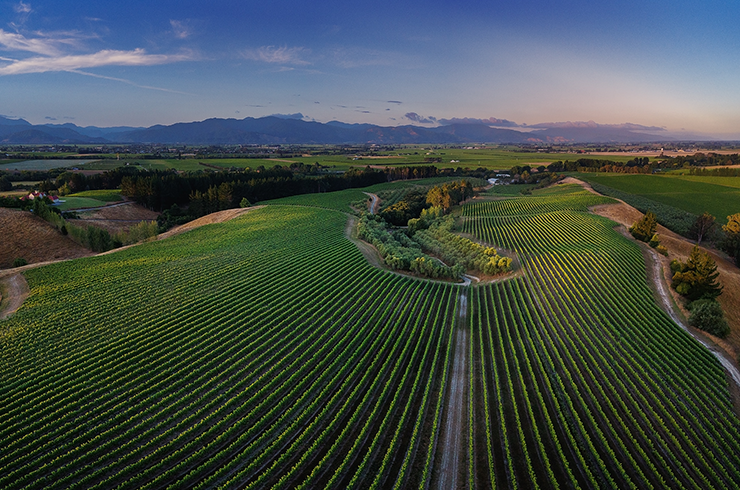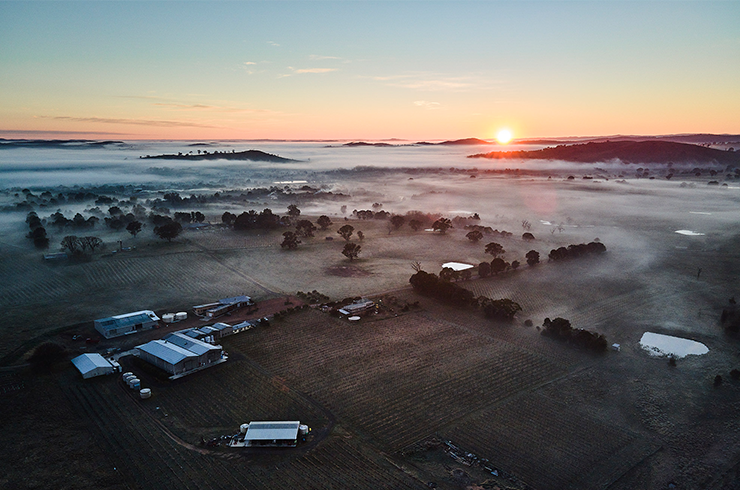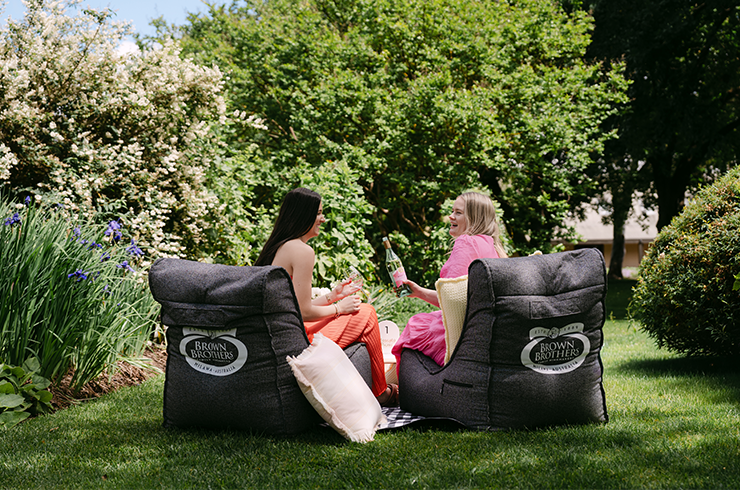McLaren Vale has long struggled with an identity crisis. It has looked enviably at other wine regions with instantly recognisable styles, such as Barossa shiraz, Clare riesling and Coonawarra cabernet [although you could argue that grenache is now becoming that for McLaren Vale]. However, such a narrow focus denies the region’s great asset that many varieties grow well, producing an extraordinary palette of possibility.
It has exceptional old vines bearing incredible fruit of depth and unique flavour, and especially strong recent plantings of less-familiar Mediterranean varieties. It’s therefore in the hands of winemakers to define McLaren Vale’s vinous soul and leading the pack is Stephen Pannell.
The canny winemaker focuses on a lean, yet complex style, achieving ideal balance between acid, ripeness and mild tannins. Since opening his SC Pannell winery and cellar door at McLaren Vale in 2014, his innovative blends have had everyone talking – tempranillo and touriga; touriga, cabernet and mataro; grenache, shiraz and touriga. They show gentle juiciness and lively spice notes in harmony, their sublime beauty heightened through having the volume turned down. But it’s Stephen’s new angle on classics that deserve more attention for boldly pursuing a fresh direction. His Syrah is taut and restrained with a seductively silky palate, while his Shiraz has a pretty nose of violets and fresh berries offset by grunty tannins driving big bass notes.
Such change signals a fresh look at McLaren Vale’s historical vine assets. Emmanuelle and Toby Bekkers capture this in Bekkers Syrah and Grenache – full yet fragrant, silky on the palate but with a pinch of spiciness. The husband-and-wife partnership presents a smart connection between intelligent viticulture and gentle winemaking, allowing the grapes to speak softly but with a distinctive, deliberate voice.
A home of alternative varieties
The region’s mild Mediterranean climate has prompted many McLaren Vale growers and winemakers to embrace alternative varieties, with very encouraging results.
Hither & Yon presents an especially enticing portfolio – think tannat, aglianico, tempranillo, nero d’avola, rosato (made from muscat rouge) and petit blanc (from muscat blanc) – thanks to brothers Richard and Malcolm Leask combining studious viticulture on the family’s vineyards with smart, contemporary winemaking to present deliciously fresh, approachable wines. At Beach Road, Briony Hoare has also pursued savoury, food-friendly, medium-bodied wines through a host of Mediterranean varieties – fiano, greco, pinot grigio, aglianico, primitivo and nero d’avola. It’s no surprise that her cellar door boasts a wood-fired oven so tasters can sample the wines with pizza.
Oliver’s Taranga has a fascinating mix of elite ancient vines (that provide fruit for Penfolds Grange and the winery’s own HJ Reserve Shiraz), with such new sensations as mencia, made as a fragrant, crisp rosé, like a feisty, playful take on Beaujolais. Coriole has planted the deliciously dry French white grape picpoul, an interesting deviation from the brand’s strong Italian-accented portfolio. Proprietor Mark Lloyd is a strong believer in the potential of alternative varieties, having been first to plant sangiovese vines in 1985. “They suit our landscape,” he says. “Now that the vines have reached full maturity and we have learned how to get the best results from them, I can see that our decision to work with these varieties was absolutely correct.”
Vigna Bottin is another shining example of how strongly Italian grape varieties perform in McLaren Vale. Winemaker Paolo Bottin consistently produces fine barbera, sangiovese, nero d’avola, vermentino and his latest addition is fiano.
A matter of technique
Beyond choosing distinctive varieties, more winemakers are making their mark through bold experimentation in technique. Brad Hickey is restlessly working on achieving complex texture in his wines at Brash Higgins, using approaches such as co-fermentation.
Stepping even further outside conventional boundaries, Brad has also experimented with chardonnay developed under flor in barrel, producing a heavy, savoury palate offset by a sharp Fino-like mouthfeel. “The options of what to do are endless,” he says. “I want to explore more of them.”
Battle of Bosworth has followed a different technical route, producing its outstanding preservative-free Puritan Shiraz since 2010. It was a bold move by Joch Bosworth, but he got it right from the outset, capturing vibrant juiciness in the bottle – the essence of his organic vineyard’s bright fruit flavours.
Defining their own terroir
McLaren Vale is telling an increasingly detailed story of provenance, having published a complex geology map in 2010 that details a crazy patchwork of more than 50 sub-soils and formations laid across the region. It helps explain the story of terroir to consumers, but has also instilled great confidence among winemakers to tell more specific and detailed stories about their wines. This is expressed through the Scarce Earth project – a branded collection of single vineyard shiraz from different McLaren Vale wineries, with consecutive vintages released since 2009, focusing on site characteristics over homogenised style. Yangarra Estate promotes the unique qualities of its vineyards by isolating its best blocks as Ironheart Shiraz and High Sands Grenache, the latter responsible for James Halliday’s 2020 Wine of the Year. Notably, when Yangarra’s US owners, the Jackson family, also purchased the famed Hickenbotham vineyards at Clarendon in 2012, they chose not to incorporate this esteemed fruit in Yangarra wines, but instead bottle them separately as Hickenbotham Clarendon Vineyard wines. “Each of these wines has its own powerful story to tell, and we’d be foolish not to recognise and celebrate that,” says Yangarra winemaker Peter Fraser.
This is an edited extract of an article that originally appeared in issue #33 of Halliday magazine. For more features on Australian wine regions, subscribe today.
It has exceptional old vines bearing incredible fruit of depth and unique flavour, and especially strong recent plantings of less-familiar Mediterranean varieties. It’s therefore in the hands of winemakers to define McLaren Vale’s vinous soul and leading the pack is Stephen Pannell.
The canny winemaker focuses on a lean, yet complex style, achieving ideal balance between acid, ripeness and mild tannins. Since opening his SC Pannell winery and cellar door at McLaren Vale in 2014, his innovative blends have had everyone talking – tempranillo and touriga; touriga, cabernet and mataro; grenache, shiraz and touriga. They show gentle juiciness and lively spice notes in harmony, their sublime beauty heightened through having the volume turned down. But it’s Stephen’s new angle on classics that deserve more attention for boldly pursuing a fresh direction. His Syrah is taut and restrained with a seductively silky palate, while his Shiraz has a pretty nose of violets and fresh berries offset by grunty tannins driving big bass notes.
Such change signals a fresh look at McLaren Vale’s historical vine assets. Emmanuelle and Toby Bekkers capture this in Bekkers Syrah and Grenache – full yet fragrant, silky on the palate but with a pinch of spiciness. The husband-and-wife partnership presents a smart connection between intelligent viticulture and gentle winemaking, allowing the grapes to speak softly but with a distinctive, deliberate voice.
A home of alternative varieties
The region’s mild Mediterranean climate has prompted many McLaren Vale growers and winemakers to embrace alternative varieties, with very encouraging results.
Hither & Yon presents an especially enticing portfolio – think tannat, aglianico, tempranillo, nero d’avola, rosato (made from muscat rouge) and petit blanc (from muscat blanc) – thanks to brothers Richard and Malcolm Leask combining studious viticulture on the family’s vineyards with smart, contemporary winemaking to present deliciously fresh, approachable wines. At Beach Road, Briony Hoare has also pursued savoury, food-friendly, medium-bodied wines through a host of Mediterranean varieties – fiano, greco, pinot grigio, aglianico, primitivo and nero d’avola. It’s no surprise that her cellar door boasts a wood-fired oven so tasters can sample the wines with pizza.
Oliver’s Taranga has a fascinating mix of elite ancient vines (that provide fruit for Penfolds Grange and the winery’s own HJ Reserve Shiraz), with such new sensations as mencia, made as a fragrant, crisp rosé, like a feisty, playful take on Beaujolais. Coriole has planted the deliciously dry French white grape picpoul, an interesting deviation from the brand’s strong Italian-accented portfolio. Proprietor Mark Lloyd is a strong believer in the potential of alternative varieties, having been first to plant sangiovese vines in 1985. “They suit our landscape,” he says. “Now that the vines have reached full maturity and we have learned how to get the best results from them, I can see that our decision to work with these varieties was absolutely correct.”
Vigna Bottin is another shining example of how strongly Italian grape varieties perform in McLaren Vale. Winemaker Paolo Bottin consistently produces fine barbera, sangiovese, nero d’avola, vermentino and his latest addition is fiano.
A matter of technique
Beyond choosing distinctive varieties, more winemakers are making their mark through bold experimentation in technique. Brad Hickey is restlessly working on achieving complex texture in his wines at Brash Higgins, using approaches such as co-fermentation.
Stepping even further outside conventional boundaries, Brad has also experimented with chardonnay developed under flor in barrel, producing a heavy, savoury palate offset by a sharp Fino-like mouthfeel. “The options of what to do are endless,” he says. “I want to explore more of them.”
Battle of Bosworth has followed a different technical route, producing its outstanding preservative-free Puritan Shiraz since 2010. It was a bold move by Joch Bosworth, but he got it right from the outset, capturing vibrant juiciness in the bottle – the essence of his organic vineyard’s bright fruit flavours.
Defining their own terroir
McLaren Vale is telling an increasingly detailed story of provenance, having published a complex geology map in 2010 that details a crazy patchwork of more than 50 sub-soils and formations laid across the region. It helps explain the story of terroir to consumers, but has also instilled great confidence among winemakers to tell more specific and detailed stories about their wines. This is expressed through the Scarce Earth project – a branded collection of single vineyard shiraz from different McLaren Vale wineries, with consecutive vintages released since 2009, focusing on site characteristics over homogenised style. Yangarra Estate promotes the unique qualities of its vineyards by isolating its best blocks as Ironheart Shiraz and High Sands Grenache, the latter responsible for James Halliday’s 2020 Wine of the Year. Notably, when Yangarra’s US owners, the Jackson family, also purchased the famed Hickenbotham vineyards at Clarendon in 2012, they chose not to incorporate this esteemed fruit in Yangarra wines, but instead bottle them separately as Hickenbotham Clarendon Vineyard wines. “Each of these wines has its own powerful story to tell, and we’d be foolish not to recognise and celebrate that,” says Yangarra winemaker Peter Fraser.
This is an edited extract of an article that originally appeared in issue #33 of Halliday magazine. For more features on Australian wine regions, subscribe today.



